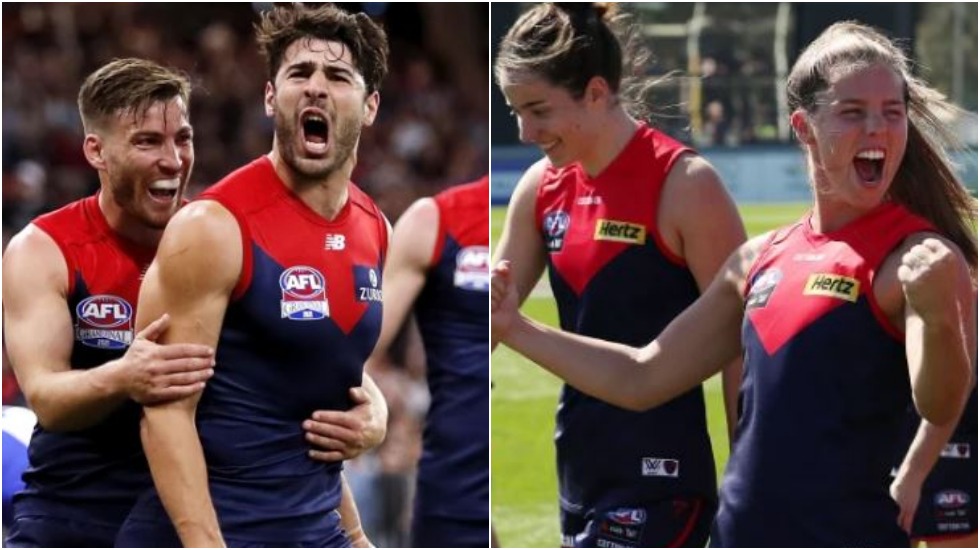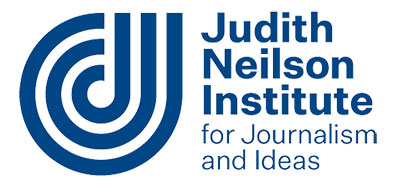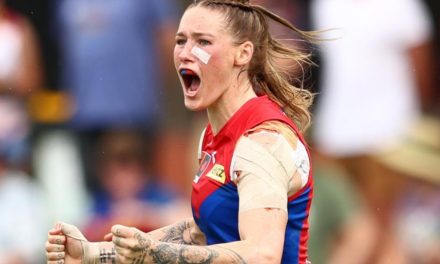Two genders, two teams, but one club and game. Melbourne’s men’s and women’s teams celebrate finals triumphs this year.
For a letter that sits inconspicuously in the middle of the alphabet, “M” really knows how to get a reaction when it attaches itself to the end of “AF and L”.
For some, the mere mention of the acronym AFLM brings on shortness of breath and a severe case of hypertension.
“Woke nonsense!” “NBA doesn’t do it”. “Virtue signalling!”.
Yes, presenting the case for the men’s competition to be rebranded as AFLM has been described by some as virtue signalling. To frame women’s rights and the ongoing pursuit of gender equality as moral grandstanding not only misses the mark, it is offensive.
There are things in the AFL that baffle me; the deliberate out of bounds rule, the booing of players who leave to play for another club, and the pronunciation of ‘defence’ as ‘dee-fence’. But adding an “M” to provide some separation between the AFL itself and its men’s competition is the logical and fair thing to do.
As it stands, the AFL is the League, the overarching governing body, and it’s also the name of the men’s competition. There is no separation here. There is with AFLW.
What this does is position the men’s competition as the default and the women’s as the “other”. To some this may seem trivial, but if we don’t challenge these assumptions, they inevitably perpetuate the notion that women’s sport is in some way secondary – that it’s an add-on, an afterthought.
This is why the language used matters.
With the growth in women’s and girls’ football, it makes sense to modernise our language by having AFLM and AFLW. It’s a clear and effective way of saying men and women play this game at the highest level and both competitions are of equal value and importance.
Such a move would shift subliminal thinking that men are the norm in this sport, and also promote the principles of equality.
PLEASE HELP US CONTINUE TO THRIVE BY BECOMING AN OFFICIAL FOOTYOLOGY PATRON. JUST CLICK THIS LINK.
It’s not as though a name change hasn’t happened before. The AFL was known as the VFL (Victorian Football League) until 1990, and VFL clubs had originally hailed from the VFA (Victorian Football Association) before that.
Societies evolve. And language does too.
The debate about whether the AFL should rename its men’s competition to match its women’s competition resurfaced this week after the A-League’s decision to rebrand itself as A-League Men and A-League Women, replacing the old A-League for men and W-League for women.
I say resurfaced because “The Outer Sanctum” podcast first raised the idea of AFLM at the start of 2017. The podcasters, and other women in sport, have been advocating for more inclusive language for years, and have often been subjected to online abuse for daring to bring gender equality into the conversation. For daring to suggest that women belong.
Subtle changes in language are already happening in sport.
Cricket Australia has the Australian Men’s Cricket Team and the Australian Women’s Cricket Team. Cricket also has the ICC Men’s World Cup and the ICC Women’s World Cup, The Hundred Men and The Hundred Women.
These changes reflect that women play elite sport too and that equality matters.
Globally, language is changing to reflect broader societal change too.
Cleveland’s Major League Baseball team has been known as the Indians since 1915, but in July this year the team decided to change its name to the Guardians after decades of protests from fans and Native American groups.
Having a long history doesn’t mean you can’t move with the times.
Adding an “M” isn’t a cryptic message for women in sport to engage in mass moonlit broomstick-waving rampages throughout every major city. Really. It’s nothing more sinister than simply including the letter ‘M’.
It won’t affect your life or change your game day experience. And it won’t fix the structural inequalities in football.
But what it might do is take us one step closer to a more vibrant and inclusive sporting culture where girls and women are not seen as ‘other’.
And who doesn’t want that?













Do the rules of the AFL specifically exclude women? If a Woman was AFL standard, could she get a game in the AFL?
It’s an important factor right?
If the AFL is technically at least open to both sexes then the name need not change, it is open to the best footballers in the world and therefore should be known as the Australian Football League, simple as that.
If the AFL is strictly male only, only then could an argument for “AFLM” be made.
Don’t get me wrong, garbage idea in any case. The competition that brings in the dollars has the right to keep it’s name. If the AFLW ever becomes anything more than a woke extravagance, then we can seriously talk of name changes.